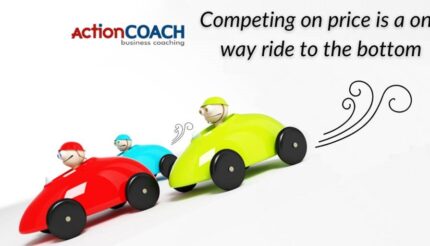These days, thanks to the wonders of the internet, it is easy for people to become professional buyers of just about anything. All the information and opinions you could ever need are available if you just ask Google. You can even spec and price a brand new car without going anywhere near a car showroom! And through some simple online comparisons, you can probably buy many products cheaper than if you went to the usual retail suppliers. While this is great for buyers, it can obviously create challenges if you are in the business of sales!
In this environment, it can be tempting for businesses to slash their prices in order to maintain their market share. But that is a no-win situation, and as a Coach, I always steer my clients away from competing on price. Because the interesting thing is – sales is not all about the price! If it were, Waitrose would have to close its stores, and unwanted BMWs would be stacking up at the docks.
Here’s what you need to know.
The Buying Decision
The truth is that people don’t buy purely on logic – it’s more complicated than that, and is all down to human psychology. In very broad terms, the human brain has two separate parts, the right and left hemispheres. We probably all know that the right side of the brain controls the left side of the body and vice versa. However, the right side of the brain also deals with emotions, while the left side deals with logic.
All decisions are made using both sides of the brain, using a combination of both logic and emotion. But years of study have shown that emotion always takes precedence when people make a buying decision. (A great source of information on the topic, for those of you who like to research issues, is Robert Cialdini’s book, “Influence: the Art of Persuasion.”)
So, how does this fact help us when we are trying to sell to customers in a price-competitive market? Well, if price is our primary focus, we end up with giving the client nothing else to base their buying decision on. If we are not satisfying their emotional needs, we should not be surprised if they go off price hunting. If we are to compete and yet keep prices up, we have to focus on the emotional factors of why people buy what we are selling. In order to do this, we need to go through 5 steps:
Step 1 – Find your niche
You can’t be everything to everyone, so focus on the segment of the market that you are ideally suited to serve. Be totally clear about the specific customers that you are looking for, and focus on being the leader in that market. Find out all you can about your target market, for example:
-
- Where are they located?
- Why do they buy your products?
- What emotions do they base their buying decisions on – what needs are they fulfilling, or what problems are they solving?
Once you have this information, you need to ensure that your marketing efforts are totally focused on your target market and their specific needs. Let them know that you understand and can solve their particular problems.
Step 2 – Define your uniqueness
Imagine that somebody who knows nothing about your business lined you up with two of your closest competitors. What would make them choose to buy from you, rather than the others? You could all be telling me the same thing, in which case my only point of differentiation would be price. And that’s the very thing you are trying to avoid competing on!
If there is really no difference in the end product or service, then you must focus on differentiating the way you deliver the product or service. This could be through the people you hire, your location, or something else that sets you apart from your competition. Once you’ve discovered what makes you better, make sure you tell people about it!
Step 3 – Sell for the relationship
People buy from people they like – so make your customers like you! Show them that you are actually interested in them. Ask them relevant questions and be helpful by making suggestions, without putting them under pressure to buy. Remember, people love to buy, but they hate being sold to.
If you pay a visit to some of the top performing businesses in the country, you will see that their customer service stands out a mile. Businesses such as Richer Sounds, Harrods and John Lewis invest heavily in their staff training. And this pays off, as they have the best customer relationships on the high street.
Step 4 – Add value, don’t discount
If you have no option but to come closer to a competitor’s pricing, then add value to the purchase, rather than discount the price. If you give a 10% discount on £100, that will be £10 straight off your bottom line profit. But if instead you give away extra goods or services with the purchase, it will cost you far less.
For example, I had a client who gave away a scarf with a retail price of £10 with every sale over £50 – i.e. 20% of the value of the sale, from the customer’s point of view. But in fact, the scarf only cost her £1.00 to buy (2% of the value). From this small investment, her overall sales were boosted, as customers loved the idea of getting a free scarf! What could you offer your clients that has a high value to them, but a low cost to you?
Step 5 – Create the WOW factor
If you really want to stand out from the crowd and get your customers to come back again and again, you have to go the extra mile. Do something that makes your customers think, “WOW, I was not expecting that!”
The ultra-successful online shoe retailer Zappos.com’s motto is, “Delivering happiness.” Their customer service team are trained to do whatever it takes to make their customers happy, proving that even in an online business, it is possible to give outstanding customer service. If you make the buying process a wonderful experience, why would your customers want to go anywhere else?
So now you know how to get over price competition, there is no excuse for not maintaining or even increasing your prices whilst growing your market share. If you tap into your customers’ emotions strongly enough, you can charge whatever you like. All it takes is a bit of imagination! So go on, take ACTION, and see your sales and profits grow!





